
Surgical Monitoring: What Happens Behind the Scenes
When your pet is scheduled for surgery, it’s completely natural to feel nervous. While you’re waiting for a call or pacing at home, you might wonder—what’s actually happening behind those clinic doors?
At Creature Comforts, safety is our highest priority, and that’s why we go above and beyond when it comes to surgical monitoring. From the moment your pet is admitted until they wake up in recovery, our team is constantly watching, measuring, and adjusting to ensure everything goes smoothly.
Here’s a look behind the scenes of your pet’s surgery day.
🐾 Why Surgical Monitoring Matters
Surgery isn’t just about making the right incision or using the best equipment, it’s about keeping your pet safe and stable every second they’re under anesthesia.
Monitoring helps us:
- Keep your pet’s heart and lungs working efficiently
- Adjust anesthesia levels in real time
- Detect and correct any changes before they become serious
- Provide a smoother, more comfortable recovery
🧪 What We Monitor During Surgery
1. Heart Rate & Rhythm
We use ECG (electrocardiogram) monitors to track your pet’s heartbeats. This allows us to detect irregular rhythms (arrhythmias) and ensure the heart is beating at a healthy rate.
2. Breathing & Oxygen Levels
Anesthesia can affect breathing, so we carefully monitor:
- Respiratory rate (how many breaths per minute)
- Oxygen saturation (SpO₂) using a pulse oximeter
- CO₂ levels to ensure your pet is exhaling properly
If adjustments are needed, we can support breathing with oxygen or mechanical ventilation.
3. Body Temperature
Under anesthesia, pets can get cold quickly. We use:
- Heating pads and warm air blankets
- Continuous temperature monitoring
- Pre- and post-warming techniques to prevent hypothermia
Maintaining a stable temperature helps reduce stress and speeds up recovery.
4. Blood Pressure
We use non-invasive blood pressure cuffs to track circulation. Low blood pressure can reduce blood flow to organs—so if needed, we adjust IV fluids or anesthesia levels to keep things balanced.
5. Depth of Anesthesia
Too much or too little anesthesia can be dangerous. Our trained nurses continuously assess your pet’s:
- Reflexes
- Eye position
- Muscle tone
- Vital signs
This allows us to adjust anesthesia dosage in real time for maximum safety.
🐶 Who's Watching Over Your Pet?
During surgery, your pet isn’t just left alone on a table. They’re constantly cared for by:
- A dedicated veterinary nurse who stays by your pet’s side from induction to recovery
- An experienced veterinarian performing the surgery
- Our monitoring equipment which gives real-time updates to the team
At Creature Comforts, we always provide one-to-one monitoring—because every heartbeat matters.
🛏 What Happens After Surgery?
Once surgery is complete, your pet is moved to our recovery area, where monitoring continues as they wake up.
We check:
- Breathing and heart rate
- Pain level and response to medications
- Temperature and mobility
Most pets go home the same day, but only when we’re 100% confident they’re safe and stable.
❓ Common Questions About Surgical Monitoring
Q: Is anesthesia dangerous?
All procedures carry some risk, but with modern monitoring and pre-anesthetic testing, the risk is very low—especially in healthy pets. We tailor every anesthesia plan based on your pet’s age, breed, and medical history.
Q: Will my pet be watched the whole time?
Absolutely. A trained nurse is assigned to monitor your pet’s vital signs throughout the procedure and during recovery.
Q: Do you use the same equipment for cats and dogs?
Yes, though settings and techniques may vary by species and size. We have species-specific protocols and equipment designed for small and large pets alike.
Q: Can I speak to the vet before surgery?
Yes. We encourage pre-surgical consults so you can ask questions, share concerns, and fully understand the plan.
